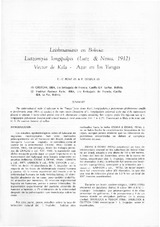Leishmaniasis en Bolivia : Lutzomyia longipalpis (Lutz & Neiva, 1912) Vector de Kala - azar en los Yungas
Abstract
Summary.
The epidemiological study of kala-azar in the "Yungas" focus shows that L. longipalpis, a predominant phlebotomine sandfly in peridomestic areas (96% of catches) is the main vector, Dissections of L. longipalpis performed at the end of the rainy season allowed to separate 5 stocks which proved close to L. donovani complex, considering their isozymic profile. The infection rate of L. longipalpis populations found around isolated houses, in rural areas, varies from 1 to 4.2%. Transmission is likely to be more active in the warmer bottoms of valleys.

